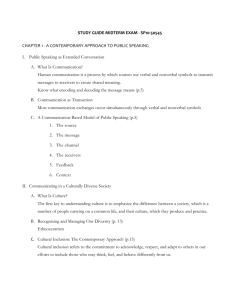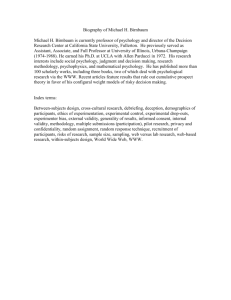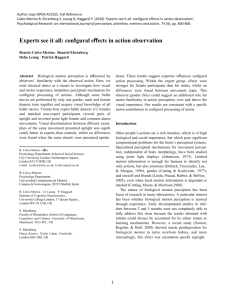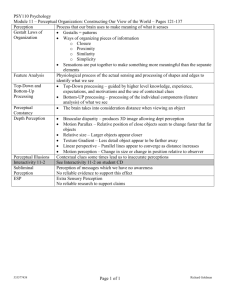Program in DOC
advertisement
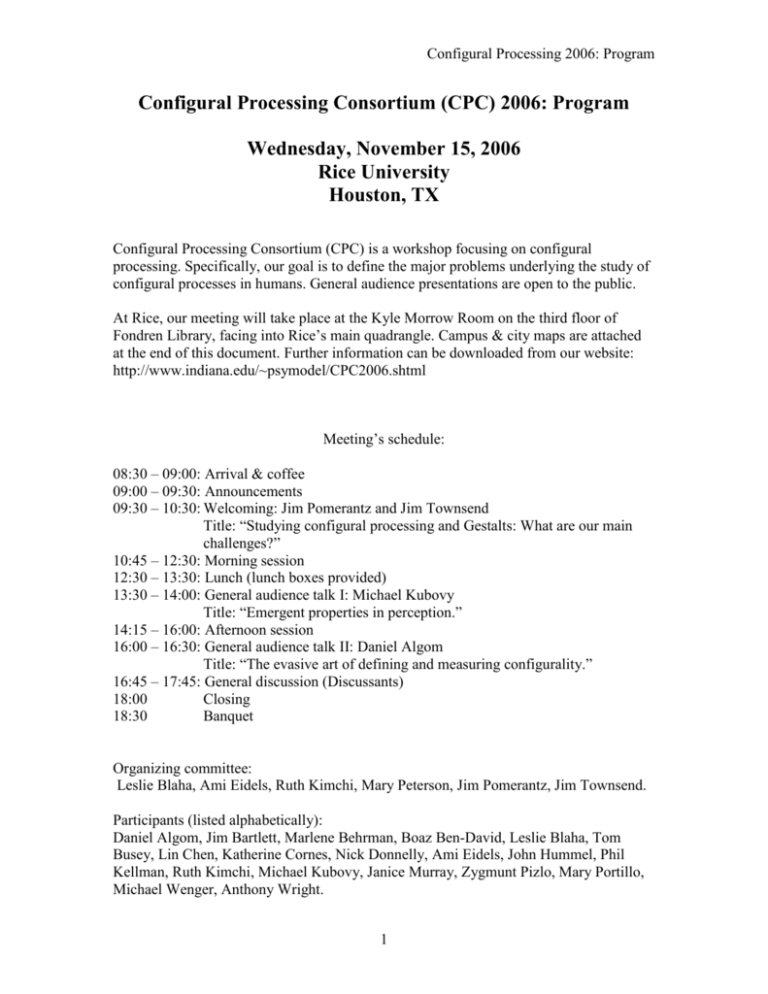
Configural Processing 2006: Program
Configural Processing Consortium (CPC) 2006: Program
Wednesday, November 15, 2006
Rice University
Houston, TX
Configural Processing Consortium (CPC) is a workshop focusing on configural
processing. Specifically, our goal is to define the major problems underlying the study of
configural processes in humans. General audience presentations are open to the public.
At Rice, our meeting will take place at the Kyle Morrow Room on the third floor of
Fondren Library, facing into Rice’s main quadrangle. Campus & city maps are attached
at the end of this document. Further information can be downloaded from our website:
http://www.indiana.edu/~psymodel/CPC2006.shtml
Meeting’s schedule:
08:30 – 09:00: Arrival & coffee
09:00 – 09:30: Announcements
09:30 – 10:30: Welcoming: Jim Pomerantz and Jim Townsend
Title: “Studying configural processing and Gestalts: What are our main
challenges?”
10:45 – 12:30: Morning session
12:30 – 13:30: Lunch (lunch boxes provided)
13:30 – 14:00: General audience talk I: Michael Kubovy
Title: “Emergent properties in perception.”
14:15 – 16:00: Afternoon session
16:00 – 16:30: General audience talk II: Daniel Algom
Title: “The evasive art of defining and measuring configurality.”
16:45 – 17:45: General discussion (Discussants)
18:00
Closing
18:30
Banquet
Organizing committee:
Leslie Blaha, Ami Eidels, Ruth Kimchi, Mary Peterson, Jim Pomerantz, Jim Townsend.
Participants (listed alphabetically):
Daniel Algom, Jim Bartlett, Marlene Behrman, Boaz Ben-David, Leslie Blaha, Tom
Busey, Lin Chen, Katherine Cornes, Nick Donnelly, Ami Eidels, John Hummel, Phil
Kellman, Ruth Kimchi, Michael Kubovy, Janice Murray, Zygmunt Pizlo, Mary Portillo,
Michael Wenger, Anthony Wright.
1
Configural Processing 2006: Program
Welcoming:
Studying configural processing and Gestalts: What are our main challenges?
James R. Pomerantz, Rice University
Gestalt Psychology will celebrate its 100th anniversary in 2012, just six years away.
What has the field accomplished to date, and what challenges remain? Our
accomplishments lie primarily in the successful demonstration of a multitude of powerful
configural phenomena and in establishing the importance and centrality of the Gestalt
question in theories of perception. Our challenges include laying down and adhering to
clear and consistent definitions for the core concepts underlying our research, building
consensus on measuring techniques, and developing formal theories for configural
effects. I will aim in this talk to expand upon and explain this analysis and to offer
suggestions for future progress.
James T. Townsend, Indiana University
Following up on Jim Pomerantz’ excellent points, it seems very likely that most, if not all
attendees to our inaugural CPC conference, would agree that a satisfactory theory of
configural perception is an admirable, if not necessary goal. There are perhaps two major
avenues for approaching theory: 1. Inductive: That is, abstracting and generalizing
empirical regularities having to do with good figures. 2. Starting with a priori ideas of
what the precepts of configural perception ‘ought’ to be. Perhaps Darwin’s theory of
evolution comes close to (1) whereas certain aspects of Einsteins special theory of
relativity (and to some extent, the general theory) bears important aspects of (2).
Theories of configural perception and cognition seem to be growing as a function of both
precepts. I will mention a few major themes in configural cognition that a general theory
should encompass. Some of them are included in my lab’s approach, others not. What
will it take?
2
Configural Processing 2006: Program
General audience talk I:
Emergent properties in perception
Michael Kubovy, University of Virginia
Gestalt phenomena---such as grouping and other forms of perceptual organization---and
configural processing---such as the perception of faces---are examples of emergent
properties (EPs). They are called EPs because one cannot predict the properties of the
complex object (a face, a melody) from the properties of the elements (the list <eyeshape, nose-shape, …>, or the list of musical notes and their associated durations). The
classic example is our inability to predict the state of matter of water at room temperature
(liquid) from the state of matter of its constituents (hydrogen and oxygen) at room
temperature (gas). Some treat emergence as if it were just a relation between properties
of elements and properties of what they constitute when they combine. This
conceptualization is observer-neutral; it makes claims about nature; it is ontological. I
will review the history of the notion of emergent property, and propose that claims of
emergence are not purely ontological; they must be stated with respect to a epistemic
framework. In other words one cannot assert that something is an emergent property in a
context in which the relation between elements and a whole is fully understood. So
within the framework of physical chemistry, the relation between H, O, and H_{2}O is
not an instance of emergence. I apply these ideas to perception, and conclude with a
classification of emergent phenomena, based on two distinctions: (1) cognitive vs.
perceptual emergence; (2) eliminative vs. preservative emergence.
General audience talk II:
The evasive art of defining and measuring configurality
Daniel Algom, Tel-Aviv University
How does something like beauty emerge? Why do some stimuli like faces or certain
emblems form compelling visual Gestalts, whereas others leave the casual observer
unaffected? Why do a brother and sister look alike? These impressions of beauty, holism,
and similarity are as immediate and compelling as are subsequent attempts at justifying
them look forced and unsatisfying. Is there a way to quantify the processing of these
stimuli, thereby distinguishing them from other non-configural stimuli? The answer
remains tentative, as attempts at deriving objective measures of configurailty have been
notoriously unsuccessful. There has long been an informal, intuitive linkage between
configurality and singularly efficient processing produced through interaction among the
various stimulus features. Another influential idea stressed the strong perceptual glue
binding together parts of configural stimuli, compromising full selective attention to
3
Configural Processing 2006: Program
parts. However, available measures of efficiency and/or capacity failed to support the
notion of supercapacity, or even dependency in processing configural stimuli. In a similar
vein, routine measures of selective attention fail to distinguish configural from nonconfigural stimuli. A possible solution to the conundrum implicates the tasks used. They
require decomposition of the stimulus or attention to a single dimension, thereby
relinquishing possible effects of stimulus holism. Tasks that preserve the stimulus as a
whole do reveal configural superiority.
Workshop presentations:
Unit formation revealed by non-linear interactions in the visual nervous system
Marlene Behrmann, Carnegie Mellon University
The Gestaltists believed that perceptual organization arose from global interactions
within the visual nervous system. Whether this is the case has always been controversial
and the emphasis placed on the physiological underpinnings of perceptual organization
has largely waned. In this talk, I examine evidence revealing how a ‘whole’ comes to be
‘greater than the sum of its parts’ at both a psychological and neural level. The data
support the claim that holistic representations reflect non-linear part-part interactions and
that these representations emerge as a function of experience with the whole. Single unit
recording in inferotemporal cortex in two monkeys performing an object discrimination
task reveals increased neural selectivity for learned versus unlearned parts. Furthermore
and of greater relevance, the findings indicate that the emergent unification of the object
is supported by enhanced firing to the specific combination of the learned parts. This
process of unification and the increase in neural selectivity for learned part-part
combinations might account for the ability of experts to discriminate among objects in
their domain of expertise based on configural or holistic representations.
Configural Learning
Leslie M. Blaha, Indiana University
Arguments and evidence abound that configural processing involves either a perceptual
representation or a cognitive processing strategy that is different from the processing of
visual objects in general. Some research argues, for example, for configurality through
holistic representations involving undifferentiated percepts (e.g. Farah, et al., 1998);
others propose that configural processing arises from highly developed or expert
processing mechanisms (e.g. Gauthier, et al., 1998; Townsend & Wenger, 2001). What is
often neglected in these arguments is an explanation for how these “special”
4
Configural Processing 2006: Program
representations or mechanisms developed to the point of configurality. So we are left
with a fundamental question: What are the processes and/or mechanisms by which we
develop either a configural perceptual representation or a configural processing strategy
(or both)? I explore various perceptual learning processes and expert-training paradigms
that represent potential candidates for the configural learning mechanisms. Such learning
appears to manifest itself in both behavioral and neurological measures, but do the
varying measures and methodologies converge on a single configural learning process?
What do EEG/ERP early perceptual components tell us about configurality?
Tom Busey & Bethany Schneider, Indiana University
In this talk we summarize the effects seen in early perceptual components such as the
P100 and N170 that have been attributed to configural or holistic processing. Our goal is
to both look for converging evidence with behavioral findings as well as to provide
some boundary conditions on what manipulations provide configural effects. We also
discuss alternative explanations for these differences that would not require configural
processing.
Tracking the development of face processing
Nick Donnelly, Katherine Cornes, Nouchine Hadjikhani and Julie Hadwin
Centre for Visual Cognition
School of Psychology
University of Southampton.
1
Martinos Center for Biomedical Imaging
Massachusetts General Hospital
Harvard Medical School.
The development of face processing across childhood and adolescence has typically been
conceived of as a transition from feature-based, orientation-invariant processing to
configural-feature, orientation-dependant processing. Although broadly correct, there are
significant problems with this view. First, there is a gap between experimental
phenomena and theoretical frameworks for configural processing creating uncertainty
over what develops across childhood and adolescence. Second, evidence of increasing
orientation dependence is drawn from studies comparing only the special cases of upright
and inverted faces. We illustrate the importance of these issues for development with
reference to detection of the Thatcher illusion.
5
Configural Processing 2006: Program
Defining Configural Processing by Elimination
Ami Eidels, Indiana University
Configural Superiority Effect (CSE) marks the faster responses on trials where certain
figures (‘configural’) are presented, compared with responses to other (‘non-configural’)
displays. Defining what makes the processing of some figures more configural than
others may be a difficult task; we can, however, employ an opposite strategy by finding
out what factors cannot account for the CSE. By constructing a sequential ideal observer
and systematically building into it mechanisms that do not lead to CSE, we can rule out
those mechanisms as possible accounts for configural processes. Candidate mechanisms
to be tested can be spatial frequency filters, attention and eye movements, and more
sophisticated neural mechanisms in the future.
Abstract Relations in Perception and Perceptual Learning
Phil Kellman, University of California, Los Angeles
Among the most important questions in vision, cognitive science, and neuroscience is the
question of how abstract descriptions (such as contour shape) are derived from early,
non-symbolic encodings (e.g., activation of local, oriented, contrast-sensitive units). The
question of abstract descriptions is equally crucial in perceptual learning (e.g., in learning
to recognize new instances of squares or dogs). I will describe recent work on contour
shape that suggests how some abstract relations may be encoded and, time permitting,
work on abstract perceptual learning that suggests how they may be discovered.
Configural coding - a continuum?
Janice Murray, University of Otago
Within the domain of face perception, a definitive characterisation of configural
processing has proved elusive. Two general points can perhaps be agreed upon. Firstly,
the perception of the spatial relations among the components or features of a face
constitutes configural processing. Secondly, the inversion effect - poorer performance in
the processing of inverted faces - is the hallmark of configural processing. On the matter
of the first point, interpretation of the term configural processing has led to a variety of
characterisations that by times appear to confuse rather than illuminate. However, this
apparent lack of consensus may actually reflect the existence of different levels of
processing of configuration when considered within the context of a continuum from
local configural information (e.g., the distance between the eyes) through to holistic
configural processing (e.g., the whole face in which the spatial relations may or may not
be explicitly represented). In my talk I will explore this possibility, linking with inversion
effects in face perception and recognition tasks, and give consideration to the feasibility
of a configural continuum in other domains.
6
Configural Processing 2006: Program
Configural processing is pervasive
Mary A. Peterson, University of Arizona
Some aspects of perception involve processing only features, but many involve
processing both features and the spatial relationships between them; a type of processing
called configural processing. Much research has been devoted to the question of whether
or not configural processing is special for faces. I will discuss examples showing that
configural processing is pervasive in perception and will argue that an important direction
for future research is to understand how configural processing is accomplished.
Prägnanz principle and 3D shape perception.
Zygmunt Pizlo, Purdue University
Perception of 3D shapes critically depends on the operation of a simplicity (Prägnanz)
principle. Simplicity can best be defined by 3D symmetries of an object. Symmetry is
the main (perhaps the only) form of spatially global redundancy, which allows the visual
system to make up for the missing information in the retinal image. When a 2D image of
an object is formed on the retina, the 3D symmetry is broken, but not eliminated. The
approximate symmetries in the 2D retinal shape can be detected and used by the visual
system to reconstruct the 3D shape. As such, the symmetry of a 3D shape percept is an
emergent property. The resulting shape percept is different from the sum of the shape’s
parts in the sense that the symmetry constraint is applied to the 3D shape as a whole, not
to the parts separately. For example, edges and surfaces of a Necker cube are perceived
as 3D because they are edges and surfaces of a 3D symmetric shape. In the case of
complex objects, such as animal or human bodies, 3D parts can be identified by using a
criterion according to which parts have more symmetries than the whole object.
Decisional factors in configural processing
Michael Wenger, Pennsylvania State University
Modal conceptions of configurality stress sensory and perceptual factors, such as
correlations in the coded representations and the rates of processing those representations.
However, consideration of a set of behavioral regularities posited as "signatures" of
configurality reveals that such effects may also arise from changes in response criteria.
Intriguingly, a set of empirical tests of these regularities---using stimuli ranging from
hierarchical forms to words and faces---has documented that such decisional effects are at
work, and may be a regular aspect of processing configural forms. This talk will propose
a set of ways that such decisional effects might arise, including cognitive/strategic
factors, potential influences of correlated noise, and potential effects due to sustained
7
Configural Processing 2006: Program
activation in various cortical regions. Consideration of these and other possible
sources for decisional effects raises questions about the conceptual validity of decisional
influences in models of configural processing.
Wholes, Holes, and Objects in Selective Attention
K Zhou and L Chen
State Key Laboratory of Brain and Cognitive Science
Chinese Academy of Sciences
What is a perceptual object? The topological approach (e.g., Chen, Science, 1982; Visual
Cognition, 2005) holds that topological properties, including holes, constitute a formal
description of perceptual organizations, such as distinguishing figure from background,
and parsing visual scenes into potential objects. According to this approach, a perceptual
object may be understood as something that preserves its topological structure over time.
The topological approach, therefore, ties the formal definition of object to invariance over
topological transformation, and the core intuitive notion of a perceptual object – the
holistic identity preserved over shape-changing transformations – may be precisely
characterized as topological invariants. The topological definition of object implies that
topological changes in holes should be interpreted by the visual system as the presence of
a new object. This prediction was verified by various paradigms, including MOT, precueing, and capture attention. Our fMRI scans further found that changes in holes in
MOT specifically activated the anterior temporal lobe, indicating, together with our
previous fMRI results (Zhuo et al., Science, 2003), that the anterior temporal lobe may
play a major role in the perception of topological invariance as well as of new perceptual
objects.
8
Configural Processing 2006: Program
Map from Hilton Americas Hotel to the Rice campus (violet line)
9
Configural Processing 2006: Program
Detailed map of the Rice campus with X showing Fondren Library
10
